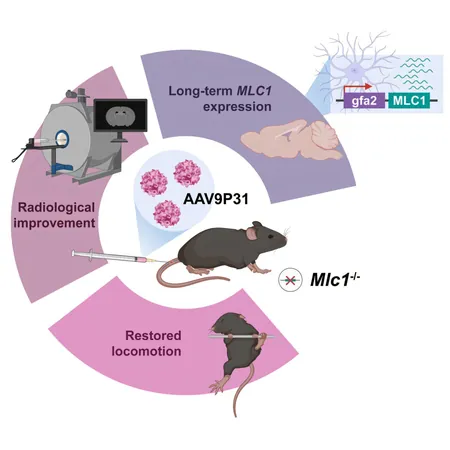
Breakthrough in Gene Therapy: Reversing Rare Neurological Disease Symptoms in Animal Models!
2025-03-31
Author: Ming
Breakthrough in Gene Therapy: Reversing Rare Neurological Disease Symptoms in Animal Models!
In a groundbreaking study conducted by the University of Autònoma de Barcelona (UAB), researchers have revealed that gene therapy may successfully restore motor function in patients suffering from a rare childhood neurological disorder known as megalencephalic leukoencephalopathy with subcortical cysts (MLC). The most exciting part? Treatment can begin even after symptoms have already manifested!
MLC, an ultra-rare condition affecting the brain's white matter, is characterized by several debilitating symptoms including enlarged head size (macrocephaly), difficulties with motor coordination, and seizures. This cruel disorder predominantly affects children, with over 75% of cases linked to mutations in the MLC1 gene. This gene is crucial for producing a protein found in astrocytes—specialized brain cells that help maintain the brain's water and ion balance. Unfortunately, the precise functions of this protein remain somewhat of a mystery to scientists.
In this significant study, led by Assumpció Bosch from UAB's Department of Biochemistry and Molecular Biology, the team employed a viral vector that delivered a healthy version of the MLC1 gene directly into an animal model afflicted with the disease. The results were astonishing. Not only did the gene expression persist in the brain for an entire year, but the treatment also normalized brain function and reversed motor deficits in the treated mice.
Alejandro Brao, a researcher involved in the study and its primary author, described the findings as a remarkable advancement, stating, “This suggests that gene therapy could be effective even in patients with advanced stages of the disease.” The implications are profound, especially considering how devastating MLC can be for affected families.
Looking ahead, the research team is eager to identify the most effective gene therapy vector suitable for clinical applications. They are also focused on determining the optimal dosage needed for therapeutic effect and ensuring the safety and distribution of the treatment in larger animal models.
This exciting research not only suggests new pathways for treating MLC patients but may also enhance our understanding of how gene therapy can be utilized to tackle various rare neurological diseases. As the scientific community watches progress closely, we can only hope that these findings pave the way for future clinical trials and ultimately help children around the world inflicted by this challenging disorder!



 Brasil (PT)
Brasil (PT)
 Canada (EN)
Canada (EN)
 Chile (ES)
Chile (ES)
 Česko (CS)
Česko (CS)
 대한민국 (KO)
대한민국 (KO)
 España (ES)
España (ES)
 France (FR)
France (FR)
 Hong Kong (EN)
Hong Kong (EN)
 Italia (IT)
Italia (IT)
 日本 (JA)
日本 (JA)
 Magyarország (HU)
Magyarország (HU)
 Norge (NO)
Norge (NO)
 Polska (PL)
Polska (PL)
 Schweiz (DE)
Schweiz (DE)
 Singapore (EN)
Singapore (EN)
 Sverige (SV)
Sverige (SV)
 Suomi (FI)
Suomi (FI)
 Türkiye (TR)
Türkiye (TR)
 الإمارات العربية المتحدة (AR)
الإمارات العربية المتحدة (AR)